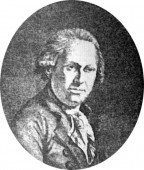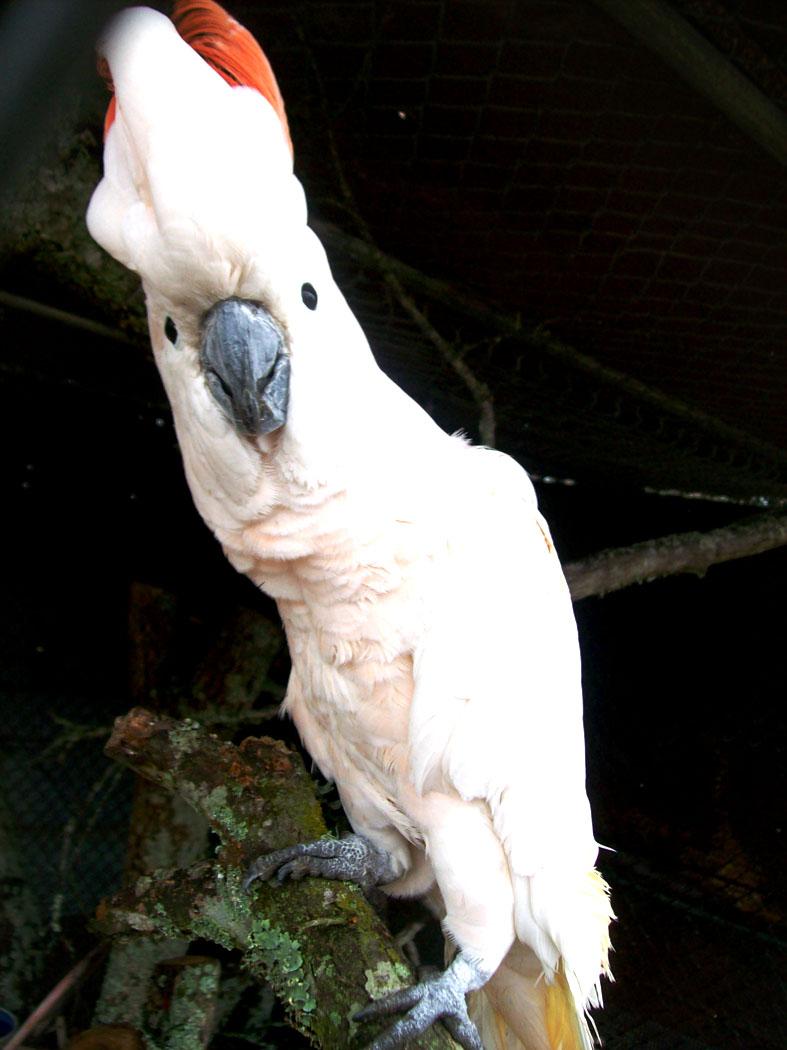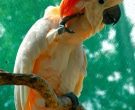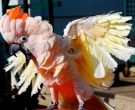Content |
|---|
Description
40 to 50 cm.. length and a weight of up to 900 gr.
The plumage of the Salmon-crested cockatoo (Cacatua moluccensis) is predominantly white, except the tuft, that consists of red feathers that is usually when the bird is excited.
The interior of the wings is light salmon color. The the tail feathers they have a yellow-orange and pink color at the base.
The bill is strong, curved and black. The legs also are of color black. A skin bare of color white blue surrounds them eyessexual dimorphism It is in the color of your eyes. Males have dark eyes while females have them red.
The immature are like adults.
- Sound of the Salmon-crested cockatoo.
Habitat:
Video – "Salmon-crested cockatoo" (Cacatua moluccensis) |
|---|
It shows preference for forests. It is from sea level up to the 1200 metres of elevation. In noisy roosts, during the breeding season, alone or in couples; at other times are found in groups of up to 16 birds. Species usually shy. You enable in the early morning and at dusk.
Reproduction:
The breeding season exact in the nature is unknown, but the activity of nesting It has observed in mayo, July and August, When the birds are usually seen alone or in pairs. The nests are built in large trees, taking advantage of holes in the trunks to 25 meters above the ground. The implementation size in captivity is from one to three, usually two, the eggs, they are incubated by both parents for 28 to 29 days.
Food:
With feeds fruit, grains, seeds, berries, vegetables and dried fruits. It has a peak strong, able to break the hard shells.
Probably also feed on insects and their larvae and from time to time in the coconut plantations, where Peck young fruits, to reach the water and the meat of the content.
Distribution:
Size of the area of distribution (reproduction / resident): 33.800 km2
Lives in the Plains to low height in the islands of the South of the Moluccas in Indonesian, Islands of Ceram, Saparua and Haruku.
It was introduced on the neighbouring island of Ambon.
Conservation:
State of conservation ⓘ |
||
|---|---|---|
 Vulnerable ⓘ (UICN)ⓘ
Vulnerable ⓘ (UICN)ⓘ
| ||
• Current category of the Red List of the UICN: Vulnerable.
• Population trend: Decreasing.
Is in the list of species at risk of CIPA (International Council for the protection of birds). It became part of the I in 1989 of the CITES and, in Europe, is covered by the program of protection of the species in extinction (EEP).
Their main threats they are the illegal trade (in great measure responsibility of Indonesian) and deforestation, that has led to a dramatic loss of habitat.
In 1982, exported a total of 6.413 birds, around the 15% of all local poultry exports, Since this species is still very desired as a companion bird.
Although the international trade reported fell to zero in the Decade of 1990, them hunters will have maintained very active and the birds are sold openly in Indonesian.
Just 62.400 Salmon-crested cockatoo in the world according to the FWS Federal Register.
In the news Loro Parque Foundation has in place a “field project” for their protection and survival in their country of origin, We hope that this great work to proceed and succeed.
"Salmon-crested cockatoo" in captivity:
In captivity is quite rare and face, but he has adapted well and plays smoothly in the spaces provided.
As a pet is simply exceptional for its docility. The only drawback is the noise it emits at times when its demands are not immediately met.
Despite their exceptional behavior, we should not consider the possession of this cockatoo as a cage bird of this wonderful bird. Trade can lead in a few years to extinction.
Alternative names:
– Salmon-crested Cockatoo, Moluccan Cockatoo, Rose cackatoo (ingles).
– Cacatoès à huppe rouge, Cacatoès des Moluques (francés).
– Molukkenkakadu (alemán).
– Cacatua-das-molucas (portugués).
– Cacatúa Copete Encarnado, Cacatúa Moluqueña, Cacatúa de las Molucas (español).

Clasificación científica:
– Orden: Psittaciformes
– Familia: Cacatuidae
– Genus: Cacatua
– Nombre científico: Cacatua moluccensis
– Citation: (Gmelin, 1788)
– Protónimo: Psittacus moluccensis
Imágenes Cacatúa Moluqueña:
Fuentes:
– Avibase
– Parrots of the World – Forshaw Joseph M
– Parrots A Guide to the Parrots of the World – Tony Juniper & Mike Par
– Birdlife
– Fotos: de.wikipedia.org, Wikimedia
– Sonidos: Frank Lambert (xeno-canto)





